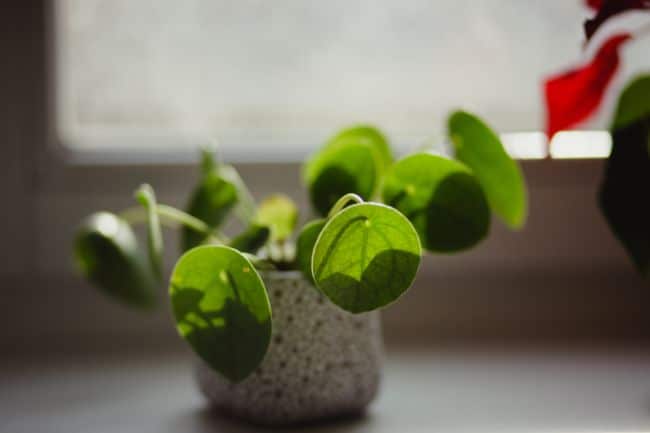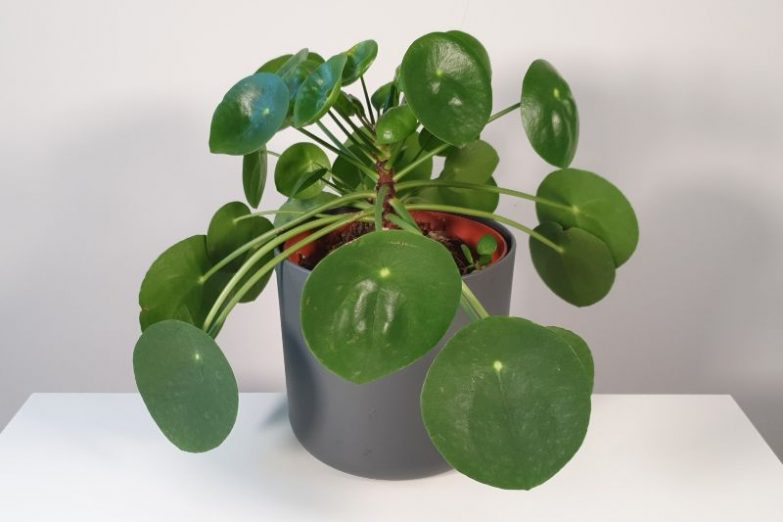The Chinese Money Plant (Pilea peperomioides) has beautiful round leaves on long petioles, that project out impressively in all directions. You may see the leaves gently curving downwards, and it can be hard to know if this is normal or if your Chinese Money Plant is drooping. This article is going to help you know when something is wrong, and what you can do to fix your plant.
A drooping appearance is often normal, particularly for Pilea peperomioides plants grown indoors. Overwatering and underwatering are also common causes of a Chinese Money Plant drooping. Too little watering causes wilting. Too much water, or soggy soil causes root rot, which also leads to wilting.
Is It Normal For A Pilea Peperomioides To Droop?
In short, it’s very common for the stems (petioles) of the Chinese Money plant to curve gently downwards, giving a drooping appearance. If the leaves look and feel healthy, and the rest of the plant is in good shape, then this is considered normal.
This growth habit is most likely to occur if the plant’s light source is coming from the side. This is a very common situation indoors, where the primary source of lighting is from a window.
You can reduce this appearance by positioning the plant where it gets most of its light from above.
Lighting from the side can also cause the entire stem to bend towards the source of light and the leaves will tend to grow towards the light, resulting in lopsided growth.
You can counteract this situation by rotating your plant every week, to ensure the stem grows vertically and the plant develops a symmetrical growth pattern.
Abnormal Causes Of A Drooping Pilea Peperomioides (Chinese Money Plant)
If you notice your plant looking unhealthy, with drooping stems and leaves, it is important to take a close look at your plant to see if something is wrong. You may see yellowing leaves, leaf drop, or other leaf or soil abnormalities which can give you clues to why your plant is so unhappy.
Underwatering
Underwatering is a common cause of a Chinese Money Plant drooping. Although the leaves of Pilea peperomioides look quite think and succulent, it is actually a plant that doesn’t tolerate underwatering very well.
If the soil dries out, it won’t be long at all before the petioles (stalks) of the leaves start to head south, creating a drooping and sad looking plant. This can also lead to leaf loss, typically affecting lower, older leaves.
This is a very simple problem to spot and fix, as the soil will be dry, and you are likely to realize it has been a while since you gave your plant a drink.
How To Fix A Chinese Money Plant Drooping Due To Underwatering
The solution is to water the soil thoroughly, making sure to drain any excess water. Try to develop a routine of checking your plant, and feeling the soil every few days to see how wet it is, watering once the top 2-3 inches of soil feels dry.
I normally check by sticking my finger right into the soil beside the plant and feeling how deep I need to go before I feel damp soil. Another great tip is to feel the weight of the pot.
Wet soil will make the pot feel heavy, but as it dries, the pot will feel increasingly light. You will quickly get to know exactly how light the pot should feel before your Pilea peperomioides needs to be watered.
Once you water your plant, it should perk up again in a matter of hours. Occasionally, a repeatedly underwatered plant will not revert to its previous appearance, and the stalks and leaves will continue to have a much more droopy growth habit. Prevention is certainly much better than cure.
I’ve written an article that provides plenty of helpful ways to know for sure when to water your plant. Getting this aspect of houseplant care right is one of the most critical things to avoiding a range of problems.

Overwatering
Whilst underwatering can cause your Chinese Money Plant to droop, it is unlikely to kill it. Overwatering is a different matter altogether.
If your plant is left to sit in soggy soil for a prolonged period, it will develop root rot. Initially, the plant has an abundance of water, but when the roots start dying due to the waterlogged conditions, your plant will no longer be able to access the water and nutrients it needs to survive.
An overwatered Pilea peperomioides will first develop generalized yellowing of the lower leaves, but this will then progress to marked wilting of the leaves and stem of your plant. If this happens, it means root rot has set in, and your plant is in deep trouble.
You may detect a rotting smell from the soil, the leaves may develop brown patches of disease, and newly emerging foliage my become brown/black or die completely.
How To Fix A Chinese Money Plant Drooping Due To Overwatering
You will need to act quickly to save your plant.
Here are the steps to follow;
- Gently remove your plant from the pot, so you can inspect the roots. Rotten roots will be black/brown, mushy, and offensive smelling.
- Loosen the soil from around the roots and try to identify if any healthy roots remain. These will look light brown/white in color and be firm and slightly spongy to the touch. If your plant has no healthy roots, it will not survive.
- If some healthy roots remain, gently rinse the old soil off the roots, and use sterile pruning shears to prune off all rotten roots, leaving only the healthy roots.
- Choose a new pot that is just big enough for the plant and no more. Make sure it has adequate drainage holes.
- Carefully repot your plant in new soil. Make sure to pick a well-draining mix. A regular houseplant potting mix, with 1/3 of added perlite or pumice is a good option.
- Lightly moisten the soil, rather than completely drenching it.
- Place your plant in high humidity and provide moderate lighting and temperatures. Check the soil every 1-2 days and keep it very lightly moist for the first 6 weeks.
- For more info, read this article about identifying, treating, and preventing root rot.
Is Your Pilea Drooping After Repotting?
If your Pilea starts drooping significantly after repotting, this is not a normal situation but is a result of transplant stress. It can often be accompanied by leaf loss.
Although not the most sensitive of plants when it comes to repotting, if the roots are disturbed a lot during the repotting process, they may not function well after repotting. This causes reduced water absorption by the roots, which can result in your Chinese Money Plant drooping.
The way to avoid this is to handle the roots only as much as is absolutely required during the repotting process. If your plant is rootbound when repotting, you do not need to loosen up the densely packed roots when repotting. Simply increase the pot size, backfill the pot with soil, and over time the roots will find their way into the fresh soil.
If you think your Pilea is drooping so much after repotting that you think it may not survive, you may like to consider taking it out of the soil and putting it into water.
This is likely to revive your plant in a matter of days. It will give it enough time to grow new roots and recover, and you can transplant it into soil in a few weeks time.
Pests
One cause of a Chinese Money Plant drooping that brings dread to the hearts of indoor gardeners is a pest infestation. A number of pests, including mealybugs, scale, thrips, spider mites and fungus gnats love Pilea peperomioides. They like to suck the sap out of the plump, juicy leaves, resulting in damage to the foliage, and dehydration of the plant, resulting in wilting.
Aside from being able to spot the pests themselves, you may see irregular yellow spots on the leaves or leaf loss.
Any pest infestation can be dealt with if it is caught early, so I would strongly recommend checking your plants on a regular basis. Make sure to check the undersides of the leaves, along the stems, and even in the soil. Isolate any affected plant immediately, and treat thoroughly and repeatedly, to eradicate the pests.
Low Light
Although not a direct cause of a Chinese Money Plant drooping, low light is one of the most common reasons why you may end up overwatering your plant and ending up with a sad, wilting Pilea.
Low light causes slow growth, reduced water use, and reduced evaporation of water, resulting in soil that stays wetter for longer. If you want to avoid root rot, and subsequently a drooping Pilea, move your plant to somewhere that gets plenty of bright, indirect light.
Just make sure to avoid direct sunlight, as this will cause leaf scorching, which will ruin the look of your lovely plant.

Is Your Chinese Money Plant Drooping Due To Temperature Changes And Drafts?
One of the things that can result in your Chinese Money Plant drooping quite dramatically is a sudden change in temperature or a cold draft. If you expose your plant to temperatures below 55°F (13°C), it can suffer cold shock, and you will notice the entire plant drooping.
This may occur if you keep your plant outdoors in summer, and forget to bring it inside when the nights start to get cooler. Alternatively, keeping your plant close to a drafty window, or air conditioning vent, can result in the same outcome.
If you notice this issue quite promptly, Pilea peperomioides has good powers of recovery. Keep it cozy, and it should be back to its best in a few days. Just take care with positioning your plant to keep it away from any drafts that might cause this problem to recur.
Old Foliage
As your Pilea peperomioides grows, older foliage, lower on the stem can start to die off. This normally starts with a leaf turning a little yellow, then drooping, and eventually dropping from the plant.
If this happens to one or two leaves at a time, and new leaves are being produced at least as quickly as they are being lost, then this is nothing to worry about.
You are more likely to see this behavior in autumn, as the light and temperature levels drop, and the plant makes some sacrifices to preserve the health of the plant coming into winter.
Last Word
Hopefully, this article has helped you determine whether your Pilea peperomioides is healthy or not. Although normal growth can result in your Chinese Money Plant drooping, don’t assume this to be the case. Check your plant carefully for any signs of problems, particularly watering issues and pests.

